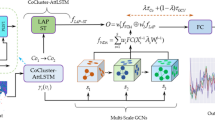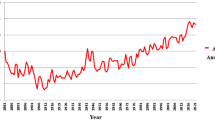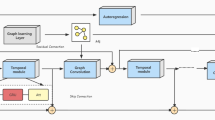Abstract
Changes in ocean temperature over time have important implications for marine ecosystems and global climate change. With the development of artificial intelligence, research on ocean temperature prediction has made some progress. However, existing methods are mostly limited to temperature prediction of isolated points on ocean surface, with less vertical studies. And existing graph neural network-based methods typically use predefined graphs, which cannot adaptively capture unknown associations between data. In this paper, we propose a new adaptive spatiotemporal dynamic graph convolution network to predict three-dimensional sea water temperature. Combined with adaptive graph learning and k nearest neighbor clustering methods, the network can automatically mine unknown dependencies between sequences based on raw data without any prior knowledge. Temporal and spatial dependencies in time series are further captured using temporal convolution and graph convolution. The graph learning, graph convolution, and temporal convolution modules are jointly learned in an end-to-end framework for the three-dimensional seawater temperature prediction task. In this paper, the prediction experiment is carried out using the high-resolution three-dimensional temperature and salt datasets from the Copernicus Global Ocean Physics Reanalysis. The results showed that our method achieved the best predictive performance on all prediction scales compared to current mainstream methods, with MAE increasing by an average of 21.7% and RMSE of 23.3%.











Similar content being viewed by others
References
Aparna SG, D’Souza S, Arjun NB (2018) Prediction of daily sea surface temperature using artificial neural networks. Int J Remote Sens 39(12):4214–4231. https://doi.org/10.1080/01431161.2018.1454623
Armenteras D, Davalos LM, Barreto JS, Miranda A, Hernandez-Moreno A, Zamorano-Elgueta C et al (2021) Fire-induced loss of the world’s most biodiverse forests in Latin America. Sci Adv 7(33):eabd3357. https://doi.org/10.1126/sciadv.abd3357
Azadifar S, Rostami M, Berahmand K, Moradi P, Oussalah M (2022) Graph-based relevancyredundancy gene selection method for cancer diagnosis. Comput Biol Med 147:105766. https://doi.org/10.1016/j.compbiomed.2022.105766
Cao LJ, Tay FH (2003) Support vector machine with adaptive parameters in financial time series forecasting. IEEE Trans Neural Netw 14(6):1506–18. https://doi.org/10.1109/TNN.2003.820556
Chen Z, Dong J (2019) Study of LSTM model in sea surface temperature prediction of the yellow sea cold water mass area. 2019 IEEE smartworld, ubiquitous intelligence & computing, advanced & trusted computing, scalable computing & communications cloud & big data computing internet of people and smart city innovation (SmartWorld/SCALCOM/UIC/ATC/CBDCom/IOP/SCI). IEEE, New York, pp 367–371
Cho K, Merrienboer Bv, Gülçehre Ç, Bahdanau D, Bougares F, Schwenk H, et al (2014) Learning phrase representations using RNN encoder–decoder for statistical machine translation. EMNLP, pp 1724–1734
Daniel L, Sigauke C, Chibaya C, Mbuvha R (2020) Short-term wind speed forecasting using statistical and machine learning methods. Algorithms 13(6):132. https://doi.org/10.3390/a13060132
Dong W, Wozniak M, Wu J, Li W, Bai Z (2022) De-noising aggregation of graph neural networks by using principal component analysis. IEEE Trans Ind Inform. https://doi.org/10.1109/tii.2022a.3156658
Dong W, Wu J, Zhang X, Bai Z, Wang P, Woźniak M (2022) Improving performance and efficiency of Graph Neural Networks by injective aggregation. Knowl Based Syst. https://doi.org/10.1016/j.knosys.2022b.109616
Eveson JP, Hobday AJ, Hartog JR, Spillman CM, Rough KM (2015) Seasonal forecasting of tuna habitat in the Great Australian Bight. Fish Res 170:39–49. https://doi.org/10.1016/j.fishres.2015.05.008
Funk CC, Hoell A (2015) The leading mode of observed and CMIP5 ENSO-residual sea surface temperatures and associated changes in Indo-Pacific climate*. J Clim 28(11):4309–4329. https://doi.org/10.1175/jcli-d-14-00334.1
Geng X, Xu L, He X, Yu J (2021) Graph optimization neural network with spatio-temporal correlation learning for multi-node offshore wind speed forecasting. Renew Energy 180:1014–1025. https://doi.org/10.1016/j.renene.2021.08.066
Graf R, Aghelpour P (2021) Daily river water temperature prediction: a comparison between neural network and stochastic techniques. Atmosphere. https://doi.org/10.3390/atmos12091154
Graf R, Zhu S, Sivakumar B (2019) Forecasting river water temperature time series using a wavelet–neural network hybrid modelling approach. J Hydrol. https://doi.org/10.1016/j.jhydrol.2019.124115
Guo K, Hu Y, Qian Z, Sun Y, Gao J, Yin B (2022) Dynamic graph convolution network for traffic forecasting based on latent network of laplace matrix estimation. IEEE Trans Intell Trans Syst 23(2):1009–1018. https://doi.org/10.1109/tits.2020.3019497
He X, Shi S, Geng X, Xu L, Zhang X (2021) Spatial-temporal attention network for multistep-ahead forecasting of chlorophyll. Appl Intell 51(7):4381–4393. https://doi.org/10.1007/s10489-020-02143-y
Heddam S, Kim S, Danandeh Mehr A, Zounemat-Kermani M, Ptak M, Elbeltagi A et al (2022) Bat algorithm optimised extreme learning machine (Bat-ELM): a novel approach for daily river water temperature modelling. Geogr J. https://doi.org/10.1111/geoj.12478
Hou S, Li W, Liu T, Zhou S, Guan J, Qin R et al (2021) D2CL: a dense dilated convolutional LSTM model for sea surface temperature prediction. IEEE J Sel Top Appl Earth Obs Remote Sens 14:12514–12523. https://doi.org/10.1109/jstars.2021.3128577
Klicpera J, Bojchevski A, Günnemann S (2019) Predict then propagate: graph neural networks meet personalized pagerank. ICLR
Lins ID, Araujo M, Moura MdC, Silva MA, Droguett EL (2013) Prediction of sea surface temperature in the tropical Atlantic by support vector machines. Comput Stat Data Anal 61:187–198. https://doi.org/10.1016/j.csda.2012.12.003
Liu Y, Fu W (2018) Assimilating high-resolution sea surface temperature data improves the ocean forecast potential in the Baltic Sea. Ocean Sci 14(3):525–541. https://doi.org/10.5194/os-14-525-2018
Liu S, Grassotti C, Liu Q, Zhou Y, Lee Y-K (2022) Improvement of miRS sea surface temperature retrievals using a machine learning approach. IEEE J Sel Top Appl Earth Obs Remote Sens 15:1857–1868. https://doi.org/10.1109/jstars.2022.3151002
Nirmala M, Sundaram SM (2010) El Nino based intervention analysis of Rainfall in Tamilnadu. Recent advances in space technology services and climate change 2010 (RSTS & CC-2010). IEEE, New York, pp 235–239
Peng W, Chen Q, Zhou S, Huang P (2021) CMIP6 model-based analog forecasting for the seasonal prediction of sea surface temperature in the offshore area of China. Geosci Lett. https://doi.org/10.1186/s40562-021-00179-7
Qiao B, Wu Z, Tang Z, Wu G (2021) Sea Surface Temperature Prediction Approach Based on 3D CNN and LSTM with Attention Mechanism. In: 2021 23rd international conference on advanced communication technology (ICACT), pp 342-347
Rahmani F, Lawson K, Ouyang W, Appling A, Oliver S, Shen C (2020) Exploring the exceptional performance of a deep learning stream temperature model and the value of streamflow data. Environmental Research Letters. https://doi.org/10.1088/1748-9326/abd501
Rostami M, Oussalah M, Farrahi V (2022) A novel time-aware food recommender-system based on deep learning and graph clustering. IEEE Access. 10:52508–52524. https://doi.org/10.1109/access.2022.3175317
Shi X, Chen Z, Wang H, Yeung D-Y, Wong W-k, Woo W-c (2015) Convolutional LSTM Network: a machine learning approach for precipitation nowcasting. In: Proceedings of the 28th international conference on neural information processing systems, MIT Press, Montreal, Vol 1, pp 802–810
Shih S-Y, Sun F-K, Lee H-y (2019) Temporal pattern attention for multivariate time series forecasting. Mach Learn 108(8–9):1421–1441. https://doi.org/10.1007/s10994-019-05815-0
Song T, Jiang J, Li W, Xu D (2020) A deep learning method With merged LSTM neural networks for SSHA prediction. IEEE J Sel Top Appl Earth Obs Remote Sens. 13:2853–2860. https://doi.org/10.1109/jstars.2020.2998461
Sun Y, Yao X, Bi X, Huang X, Zhao X, Qiao B (2021) Time-series graph network for sea surface temperature prediction. Big Data Res. https://doi.org/10.1016/j.bdr.2021.100237
Thongniran N, Jitkajornwanich K, Lawawirojwong S, Srestasathiern P, Vateekul P (2019) Combining attentional CNN and GRU networks for Ocean current prediction based on HF radar observations. In: Proceedings of the 2019 8th international conference on computing and pattern recognition, pp 440-446
Wang L, Xu B, Zhang C, Fu G, Chen X, Zheng Y et al (2022) Surface water temperature prediction in large deep reservoirs using a long short term memory model. Ecol Indic. https://doi.org/10.1016/j.ecolind.2021.108491
Wei X, Liu Y, Gao S, Wang X, Yue H (2019) An RNN-based delay-guaranteed monitoring framework in underwater wireless sensor networks. IEEE Access 7:25959–25971. https://doi.org/10.1109/access.2019.2899916
Wolff S, O’Donncha F, Chen B (2020) Statistical and machine learning ensemble modelling to forecast sea surface temperature. J Mar Syst. https://doi.org/10.1016/j.jmarsys.2020.103347
Xiao C, Chen N, Hu C, Wang K, Xu Z, Cai Y et al (2019) A spatiotemporal deep learning model for sea surface temperature field prediction using time-series satellite data. Environ Model Softw. https://doi.org/10.1016/j.envsoft.2019.104502
Xie J, Zhang J, Yu J, Xu L (2020) An adaptive scale sea surface temperature predicting method based on deep learning with attention mechanism. IEEE Geosci Remote Sens Lett 17(5):740–744. https://doi.org/10.1109/lgrs.2019.2931728
Xu L, Li Q, Yu J, Wang L, Xie J, Shi S (2020) Spatio-temporal predictions of SST time series in China’s offshore waters using a regional convolution long short-term memory (RC-LSTM) network. Int J Remote Sens 41(9):3368–3389. https://doi.org/10.1080/01431161.2019.1701724
Xue Y, Leetmaa A (2000) Forecasts of tropical Pacific SST and sea level using a Markov model. Geophys Res Lett 27(17):2701–2704. https://doi.org/10.1029/1999gl011107
Yang YT, Dong JY, Sun X, Lima E, Mu QQ, Wang XH (2018) A CFCC-LSTM model for sea surface temperature prediction. IEEE Geosci Remote Sens Lett 15(2):207–211. https://doi.org/10.1109/Lgrs.2017.2780843
Yousefi A, Toffolon M (2022) Critical factors for the use of machine learning to predict lake surface water temperature. J Hydrol. https://doi.org/10.1016/j.jhydrol.2021.127418
Yu M, Zhang Z, Li X, Yu J, Gao J, Liu Z et al (2020) Superposition graph neural network for offshore wind power prediction. Future Gener Comp Syst 113:145–157. https://doi.org/10.1016/j.future.2020.06.024
Yu B, Yin H, Zhu Z (2018) Spatio-temporal graph convolutional networks: a deep learning framework for traffic forecasting. In: proceedings of the twenty-seventh international joint conference on artificial intelligence, IJCAI-18. International joint conferences on artificial intelligence organization, pp 3634-3640.
Zaremba W, Sutskever I, Vinyals O, (2014) Recurrent neural network regularization. arXiv.abs/1409.2329. https://doi.org/10.48550/arXiv.1409.2329.
Zhang L, Zhang R, He Q (2020) Sea surface salinity retrieval from aquarius in the South China sea using machine learning algorithm. IGARSS 2020–2020 ieee international geoscience and remote sensing symposium. IEEE, New York, pp 5643–5646
Zhang Y, Yin J, Yang S, Meng W, Han Y, Yan Z (2021) High wind speed inversion model of CYGNSS sea surface data based on machine learning. Remote Sens. https://doi.org/10.3390/rs13163324
Zhang X, Li Y, Frery AC, Ren P (2022) Sea surface temperature prediction with memory graph convolutional networks. IEEE Geosci and Remote Sens Lett 19:1–5. https://doi.org/10.1109/lgrs.2021.3097329
Zhao L, Song Y, Zhang C, Liu Y, Wang P, Lin T et al (2020) T-GCN: a temporal graph convolutional network for traffic prediction. IEEE Trans Intell Transp Syst 21(9):3848–3858. https://doi.org/10.1109/tits.2019.2935152
Zheng G, Li X, Zhang RH, Liu B (2020) Purely satellite data-driven deep learning forecast of complicated tropical instability waves. Sci Adv. 6(29):eabal482. https://doi.org/10.1126/sciadv.aba1482
Zhu S, Heddam S (2019) modelling of maximum daily water temperature for streams: optimally pruned extreme learning machine (OPELM) versus radial basis function neural networks (RBFNN). Environ Process 6(3):789–804. https://doi.org/10.1007/s40710-019-00385-8
Zhu S, Heddam S, Wu S, Dai J, Jia B (2019) Extreme learning machine-based prediction of daily water temperature for rivers. Environ Earth Sci. https://doi.org/10.1007/s12665-019-8202-7
Acknowledgments
The authors express heartfelt thanks to all the participants for the trial and the tutors who supported us. The authors benefit from tutors’ professional guidance, patient encouragement, and selfless help. Thank you for all of them.
Funding
This work is supported by the National Program on Key Research Project under Grant No. 2021YFC3101603.
Author information
Authors and Affiliations
Contributions
All authors contributed to the study conception and design. Material preparation, data collection and analysis were performed by JP and ZL. Formal analysis and Conceptualization were performed by SS and XW. Investigation, Supervision and Project administration were performed by LX and JY. The first draft of the manuscript was written by JP and all authors commented on previous versions of the manuscript. All authors read and approved the final manuscript
Corresponding authors
Ethics declarations
Competing interests
The authors declare no competing interests.
Conflict of interest
The authors have no relevant financial or non-financial interests to disclose.
Additional information
Publisher's Note
Springer Nature remains neutral with regard to jurisdictional claims in published maps and institutional affiliations.
Rights and permissions
Springer Nature or its licensor (e.g. a society or other partner) holds exclusive rights to this article under a publishing agreement with the author(s) or other rightsholder(s); author self-archiving of the accepted manuscript version of this article is solely governed by the terms of such publishing agreement and applicable law.
About this article
Cite this article
Pan, J., Li, Z., Shi, S. et al. Adaptive graph neural network based South China Sea seawater temperature prediction and multivariate uncertainty correlation analysis. Stoch Environ Res Risk Assess 37, 1877–1896 (2023). https://doi.org/10.1007/s00477-022-02371-3
Accepted:
Published:
Issue Date:
DOI: https://doi.org/10.1007/s00477-022-02371-3




